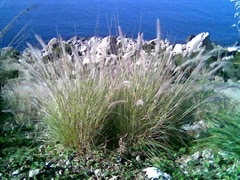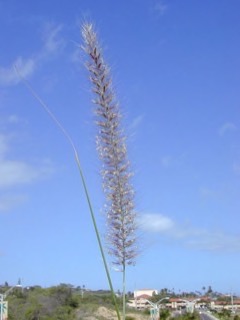 |
|
tato grasso wikimedia.org |
 |
| Forest & Kim Starr starrenvironmental.com |
Translate this page:
Summary
Physical Characteristics

 Pennisetum setaceum is a PERENNIAL growing to 1.5 m (5ft) by 1.5 m (5ft) at a fast rate.
Pennisetum setaceum is a PERENNIAL growing to 1.5 m (5ft) by 1.5 m (5ft) at a fast rate.
See above for USDA hardiness. It is hardy to UK zone 9.
Suitable for: light (sandy), medium (loamy) and heavy (clay) soils, prefers well-drained soil and can grow in nutritionally poor soil. Suitable pH: mildly acid, neutral and basic (mildly alkaline) soils. It can grow in semi-shade (light woodland) or no shade. It prefers dry or moist soil and can tolerate drought.
UK Hardiness Map
US Hardiness Map
Synonyms
Cenchrus setaceus (Forssk.) Morrone. Pennisetum cupreum Hitchc. [Invalid]. Pennisetum erythraeum Chiov. Pennisetum macrostachyum Fresen. [Illegitimate]. Pennisetum macrostachyon Fresen. [Spelling variant]. Pennisetum numidicum Paris [Invalid]. Pennisetum orientale var. altissimum Chiov. Pennisetum orientale subsp. parisii Trab. Pennisetum orientale var. parisii (Trab.) Leeke. Pennisetum parisii (Trab.) Trab. Pennisetum phalaroides Schult. [Illegitimate]. Pennisetum ruppellii Steud. Pennisetum ruppellii var. depauperatum Schweinf. Pennisetum scoparium Chiov. Pennisetum setaceum var. parisii (Trab.) Maire. Pennisetum spectabile Fig. & De Not. Pennisetum tiberiadis Boiss. Phalaris setacea Forssk.
Plant Habitats
Edible Uses
Edible Parts: Seed
Edible Uses:
Carbon Farming Solutions - Staple Crop: balanced carb (The term staple crop typically refers to a food that is eaten routinely and accounts for a dominant part of people's diets in a particular region of the world) [1-1]. A minor or regional crop in production with low or unreported yields [1-1]. A number of Pennisetum species have edible seeds - no detailed information could be found for this species.
References More on Edible Uses
Medicinal Uses
Plants For A Future can not take any responsibility for any adverse effects from the use of plants. Always seek advice from a professional before using a plant medicinally.
None Known
References More on Medicinal Uses
The Bookshop: Edible Plant Books
Our Latest books on Perennial Plants For Food Forests and Permaculture Gardens in paperback or digital formats.

Edible Tropical Plants
Food Forest Plants for Hotter Conditions: 250+ Plants For Tropical Food Forests & Permaculture Gardens.
More

Edible Temperate Plants
Plants for Your Food Forest: 500 Plants for Temperate Food Forests & Permaculture Gardens.
More

More Books
PFAF have eight books available in paperback and digital formats. Browse the shop for more information.
Shop Now
Other Uses
This plant is attractive to bees, butterflies and/or birds. Fountain grass is well adapted to fire and fires may contribute to fountain grass spread. Fountain grass is of little grazing value due to its coarse rough leaves. A popular ornamental.
Special Uses
Carbon Farming Food Forest
References More on Other Uses
Cultivation details
Management: Standard Regional Crop Staple Crop: Balanced carb
Climate: warm temperate to subtropical, Mediterranean. Humidity: semi-arid. Light: Sun to Partial Shade. Soil pH requirements: 6.1 (mildly acidic) to 7.8 (mildly alkaline). It grows in most soils, even poorly drained soils preferring exposed, dry habitats, particularly rocky areas but can also grow in sandy soils such as coastal grasslands. It is drought-tolerant and fast growing. Becomes facultativlely inactive with extended drought, freezing, or near-freezing temperatures. Carbon Farming Solutions - Cultivation: regional crop. Management: standard (Describes the non-destructive management systems that are used in cultivation) [1-1].
Carbon Farming
-
Management: Standard
Plants grow to their standard height. Harvest fruit, seeds, or other products. Non-Destructive management systems.
-
Regional Crop
These crops have been domesticated and cultivated regionally but have not been adopted elsewhere and are typically not traded globally, Examples in this broad category include perennial cottons and many nuts and staple fruits.
-
Staple Crop: Balanced carb
(0-15 percent protein, 0-15 percent oil, with at least one over 5 percent). The carbohydrates are from either starch or sugar. Annuals include maize, wheat, rice, and potato. Perennials include chestnuts, carob, perennial fruits, nuts, cereals, pseudocereals, woody pods, and acorns.
References Carbon Farming Information and Carbon Sequestration Information
Temperature Converter
Type a value in the Celsius field to convert the value to Fahrenheit:
Fahrenheit:
The PFAF Bookshop
Plants For A Future have a number of books available in paperback and digital form. Book titles include Edible Plants, Edible Perennials, Edible Trees,Edible Shrubs, Woodland Gardening, and Temperate Food Forest Plants. Our new book is Food Forest Plants For Hotter Conditions (Tropical and Sub-Tropical).
Shop Now
Plant Propagation
Plants can be grown from cuttings. It can also be grown by seeds or division of the clump. This is a very easy grass to propagate.
Other Names
If available other names are mentioned here
Fountain grass, African fountain grass, crimson fountaingrass,
Native Range
TEMPERATE ASIA: Oman, Saudi Arabia, Yemen, Egypt (Sinai), Israel, Jordan, Lebanon, Syria EUROPE: Italy (Sicilia) AFRICA: Algeria, Egypt, Libya, Morocco, Tunisia, Eritrea, Ethiopia, Sudan, Somalia, Kenya, Tanzania, Zambia, Zimbabwe
Weed Potential
Right plant wrong place. We are currently updating this section.
Please note that a plant may be invasive in one area but may not in your area so it's worth checking.
Fountain grass or African fountain grass is a highly invasive tufted grass. Plants are used as ornamentals and once escaped, this grass can form dense stands that exclude all other plants. It has been used for soil stabilisation and is a weed of pastures and alongside railway lines and roads. It interferes with natural fire regimes and competes with native species for limited resources.
Conservation Status
IUCN Red List of Threatened Plants Status : Status: Least Concern ver 3.1

Growth: S = slow M = medium F = fast. Soil: L = light (sandy) M = medium H = heavy (clay). pH: A = acid N = neutral B = basic (alkaline). Shade: F = full shade S = semi-shade N = no shade. Moisture: D = dry M = Moist We = wet Wa = water.
Now available:
Food Forest Plants for Mediterranean Conditions
350+ Perennial Plants For Mediterranean and Drier Food Forests and Permaculture Gardens.
[Paperback and eBook]
This is the third in Plants For A Future's series of plant guides for food forests tailored to
specific climate zones. Following volumes on temperate and tropical ecosystems, this book focuses
on species suited to Mediterranean conditions—regions with hot, dry summers and cool, wet winters,
often facing the added challenge of climate change.
Read More
Expert comment
Author
(Forssk.) Chiov
Botanical References
Links / References
For a list of references used on this page please go here
Readers comment
| Add a comment |
|
If you have important information about this plant that may help other users please add a comment or link below. Only comments or links that are felt to be directly relevant to a plant will be included. If you think a comment/link or information contained on this page is inaccurate or misleading we would welcome your feedback at [email protected]. If you have questions about a plant please use the Forum on this website as we do not have the resources to answer questions ourselves.
* Please note: the comments by website users are not necessarily those held by PFAF and may give misleading or inaccurate information.
To leave a comment please Register or login here All comments need to be approved so will not appear immediately.
|
Subject : Pennisetum setaceum
|
|
|
|